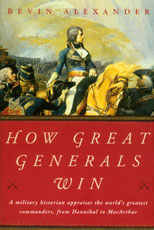 Click here to purchase from Barnes & Noble.
Click here to purchase from Amazon.com.
Click here to purchase from Barnes & Noble.
Click here to purchase from Amazon.com.
Operating on the Line of Least Expectation
and Least Resistance
Excerpt from How Great Generals Win, by Bevin Alexander, pages 300-301
Hannibal took his army through the formidable swamps of the Arnus River in Tuscany in 217 B.C. rather than face the Roman army directly. Not expecting such a move, the Romans left the route open, permitting Hannibal to emerge behind the Roman army with a clear road to Rome. This forced the Romans to abandon their strong position and rush after the Carthaginians. Hannibal ambushed the dislocated Romans at Lake Trasimene and destroyed nearly their entire army. (See page 41.)
The Carthaginians in Spain believed Scipio Africanus would strike at their armies and left unguarded their capital and principal port, New Carthage. Scipio seized this city in 209 B.C., cut off the main sea connection with Carthage, caused several Spanish tribes to come over to the Romans, and abruptly threw the Carthaginians on the strategic defensive. (See page 50.)
Genghis Khan focused the attention of the Khwarezmian army by fierce attacks on cities along the Syr Darya in Turkestan in 1220. He then led a Mongol army across the supposedly impassable Kyzyl Kum to seize Bokhara, far in the enemy rear, isolating the Khwarezmian capital of Samarkand and blocking reinforcements from the south. In a single quick campaign, the Mongols captured Samarkand and destroyed the Khwarezmian empire. (See page 82.)
In 1862, two Union armies were advancing on Staunton in Virginia’s Shenandoah Valley, while a third Union force under Irvin McDowell was marching from Fredericksburg to reinforce George McClellan, who was waiting on it to assault Richmond.. Stonewall Jackson, instead of marching against any of the three armies, crossed to a rail junction east of the Blue Ridge Mountains. Federal leaders, believing he might attack northward, stopped McDowell in place and delayed McClellan’s attack on Richmond. He now moved back into the Shenandoah Valley and forced one Union army to retreat into the Appalachian Mountains, leaving the other army isolated and vulnerable to his attack. (See page 131.)
When strong German forces attacked Holland and Belgium in 1940, British and French mobile forces rushed northward to block the advance. Erich von Manstein, knowing this would happen, had convinced Adolf Hitler to send most of his armored or panzer strength through the supposedly impassable Ardennnes to seize Sedan, which was defended only by second-rate troops. When this occurred, the German panzers had a nearly clear path westward to the English Channel, trapping the Allied armies that had rushed into Belgium and ensuring the defeat of France. (See page 219.)
<< More 'Rules of War' Excerpts << Back to top